August 3, 2008 Update July 2009
For the last week, I've had the new Starmaster 18FX under desert skies in
New Mexico. Here are a few daytime shots of the viewing site.
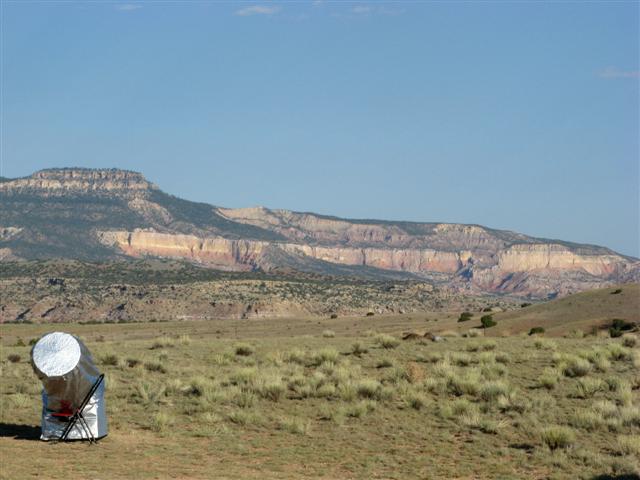
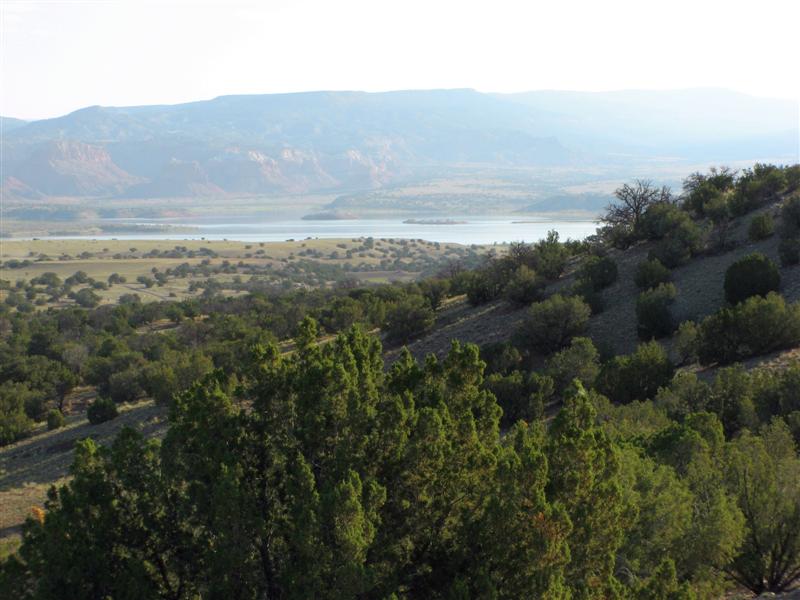
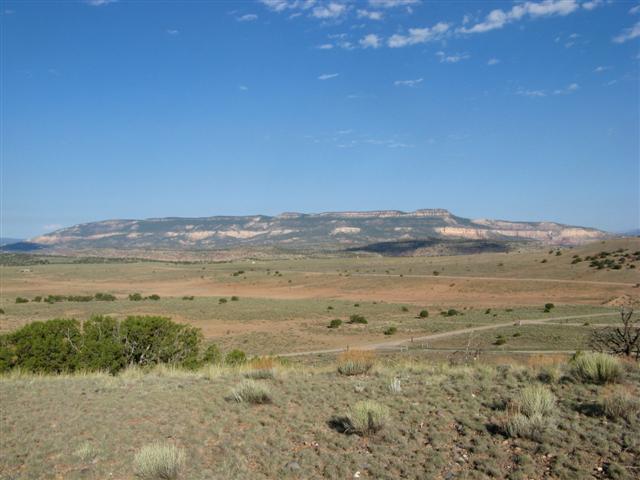
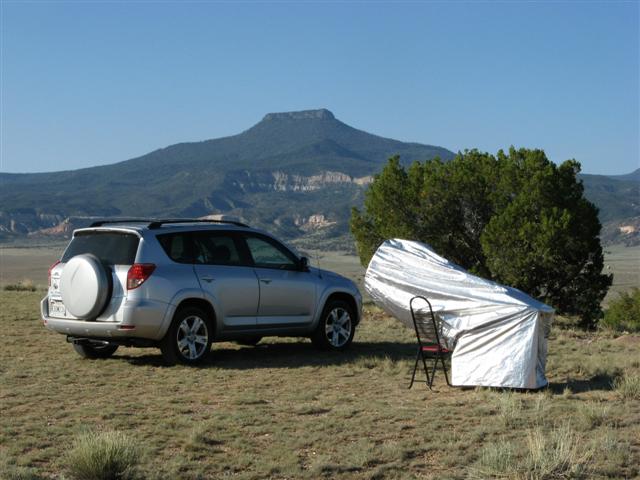
By my estimate, limiting visual magnitudes have averaged 6.4, with
small variation. Transparency has often been very good, though not
yet
the best this site can offer. Officially, it's the "rainy" season
here. So I'm still
waiting to see what the scope will do with faint
fuzzies under ideal conditions. I'll update again if the perfect
night arrives. But for six (!) nights in a row, skies were at least
good, and
often impressive. Clouds finally rolled in yesterday. Since my initial report,
I've also had the scope out for two long nights at
dark sites in good conditions--once at Cherry Springs, and once at
Spruce Knob. I've also experimented with some mirror cooling
aids, settling for now on a simple one (see below) that works
quite well, even
under the rapid change of temperature after sundown in the high desert.
So I'm starting to feel like I know the scope and what it can
deliver. This has only raised my opinion of the optics and design.
The trip west confirmed that the scope travels easily for long
distances in a Toyota RAV, with plenty of room to spare for luggage and
gear. Putting another passenger in the back--say, a medium human or
large
dog--would have been doable though a little uncomfortable.
(A refractor and tripod, however, could have gone in nicely.)
Since I can
leave the scope assembled at the site, moving it inside if bad
weather
looms,
I brought the wheelbarrow handles. They work fine. An extra
bolt is used to secure the mirror box to the rocker box in transport;
it doubled as a useful way of securing the covered scope at a good
angle during the day, since it can get a bit windy atop a
mesa.
The "sky tracker" system continues to function beautifully. Targets have always been within field
of a Panoptic 22--apart from one slew in Dobson's hole--and
often close to center (within the field of a Nagler 7). Even 180
degree
turns have not thrown the system off. Long breaks have left objects
almost dead center. And the
Veil nebula, filling the field of a Pan 35 (just over a degree),
was wonderfully steady for a long stretch
directly overhead. This made it possible to discern a lot of structure
in the Veil's wisps. Moving around slowly with the controls, I
was able to trace the entire loop. Finding a couple of
quasars--including PG1634+706, at magnitude 14.7--was
almost too simple: disengage the clutches; push to the
desired coordinates, as displayed by Sky Commander; then with a
Pan 22
or
Ethos 13, the relevant
star patterns on my charts were within the field. Once the target was
centered, seeing the quasar itself was easy. Indeed, much fainter stars
were
visible, though I haven't yet done a limiting magnitude test on the
scope. (I have, however, added some Hicksons and Abells to my "to see"
list for the coming week, given how easy 14+ magnitude objects have
been under these skies.) In case you're wondering, PG1634+706 is very far away. Its red
shift [z] is listed variously: NASA Goddard says 1.084, though numbers
around 1.33 are commonly cited. There is dispute about what this
means in terms of distance. Common estimates of 7.5 Gyr, or higher, may
be exaggerations. But by any reasonable measure, it's way
out there. Anyone who wouldn't be awestruck by seeing this object
with "just" a few pieces of well ground glass--and in my case, a
contact lens--probably isn't reading this.
Before saying any more about the optics, let me say something about
cooling and collimation. For whatever reason, fans seem to generate heat in
discussions of
Starmasters. I have not spoken with Rick Singmaster or Mike
Lockwood about this. But taking an idea from Bryan Greer,
and playing
around with some variations, I've found that the following simple
device really helps cool down the already thinnish 1.6" mirror...
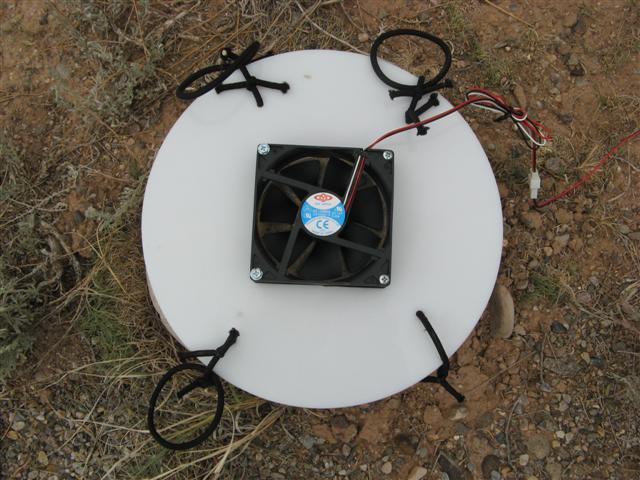
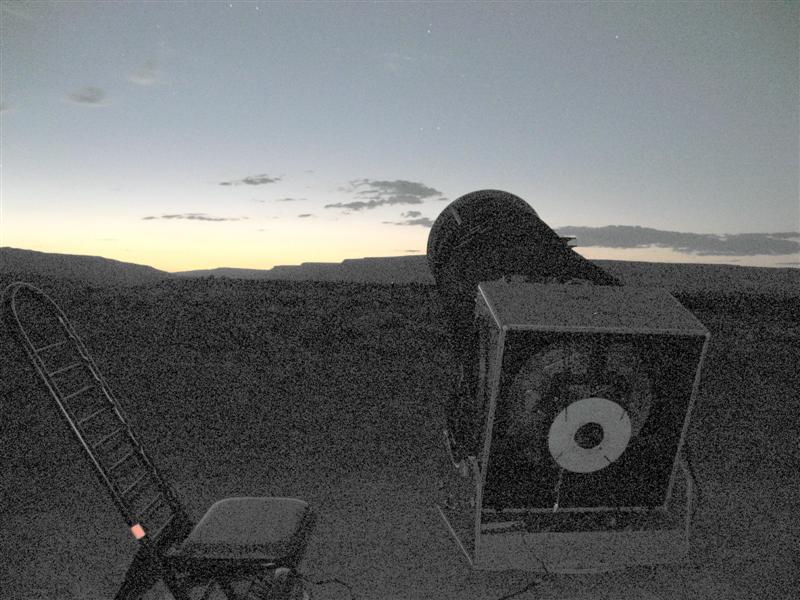
...a little computer fan,
blowing about 55 cfm, attached to a homemade baffle with holes for some
elastic
hair bands that can be looped over the grips of the four bolts used to
attach the mirror cell. Given the temperatures shortly before and
shortly after sunset
here--big difference--merely leaving the scope out in advance does
not let the mirror cool enough to yield the best possible views as soon
as it gets dark enough for serious viewing. (The views are good, but
not
yet terrific, for the first hour.) With just half an hour of help from
the
fan, however, things improve noticeably. Views of Jupiter have been
pleasing,
despite
its being relatively low in the sky, even before dark. With the
fan left in place--no clearance problems--a little vibration was
sometimes noticeable on Jupiter, but not on DSOs. That said, I
haven't needed to leave the fan in place while viewing, since I've been
able to just let it run during dinner and recharge the battery each
night. With regard to collimation, I spent some time getting it
right after the long trip, which ended with bumpy dirt roads. But once
it was nailed--all the reflections of the triangle in their proper
place--I didn't need more than a small adjustment for the rest of the
week, even when the scope was disassembled and reassembled. During any
given session, I never needed more than one slight tweak of the
secondary.
Properly cooled and collimated, the 18" Lockwood mirror performs
wonderfully. Stars are textbook pinpoints. The "wild duck" cluster
provided an especially vivid illustration, for me, of what "tack sharp"
means--and just how much difference this makes to overall viewing
experience. Using an O2 filter, I also got stunning views of the North
American nebula. After years of regarding this as a difficult object,
and seeing the "gulf" only in vague outline, I was nearly overwhelmed
by the visible detail. Likewise, I was finally able to see in my own
scope why the Eagle nebula is so named. Having identified the basic
structure, including the quite obvious rift where the "star queen"
sits, I want to go back for a much longer look and see how much detail
can be detected by someone not blessed with Stephen O'Meara's
eyes. Stephan's Quintet was easily found. After staring and breathing
for a bit, the quintet resolved into five not quite so easy
pieces. But once I knew what to look for, they emerged with less
effort, the second time around. Old friends took on a brand new
look. I spent quite a while, for example, counting and tracing the
lanes in the Andromenda galaxy--and then just starting at it along with
its two companions, framed perfectly in the Pan 35.
I have been pushing magnification on the Ring Nebula, in search of the central star, and may have
had glimpses: an occasaional blue speck, in the same place each time.
But given the power of averted imagination, I don't claim a
sighting. I do, however, want to note that I've been using a Televue
zoom intended for my refractor--ranging from 2 to 4 mm, with
a 50 degree AFOV--to get about 420x and 635x (no Paracorr). The ring
itself blurs badly, of course, but the tracking still works great,
keeping the view within a tiny window. Pushing farther, to about 850x
or close to 1000x with the Paracorr back in, requires more use of the
controller. But one can, if one wants to, keep a target on target at
powers that may be welcome on some enchanted night with Saturn high in
the sky.
I'm still no expert on star tests. But during several good (though not
perfect) windows here, and at Cherry Springs, I've had the same
experience with Vega reasonably high in the sky: at around 420x,
racking out and in, I cannot detect any distortions
or asymmetries; around 635x, I can detect a few slight
asymmetries, though it's hard to say if this is due to the optics or the
conditions; and conditions certainly haven't
supported higher powers. I feel more confident reporting on the results
of a "wild duck and Hercules" test: do the stars look the way you hoped
they would, given what you've seen in pictures and seen through other
excellent scopes of the same or slightly larger aperture? Answer, for
me: definite yes.
So what don't I like about the scope, abstracting away from its effect
on my bank account? Well, a lighter mirror and mirror box would be
nice. I'm thinking that it would be unwise to lose a lot of upper body
strength. (Otherwise, my wife will need to make enough money to buy a
place like this one and build an observatory.) Likewise, a little less
breadth would be nice when it comes to lifting and carrying. On the other hand, my view of the
Eagle nebula doesn't have me wishing for a smaller mirror. And
apart from the size issues, which I knew about in advance, no
feature of the scope has been the least bit annoying. Honest. I can
imagine that the Sky Commander would be a little basic and
under-featured for some: it's very 20th century. But I've come to
appreciate its simplicity, and even the absence of a numerical keypad.
I've also been trying out a Denkmeier II binoviewer, off and on, and
liking it on the whole. The light loss is obvious, even comparing a Pan
24 duo to a single Pan 22. But the 18 inch mirror makes it possible to
give up a little light, and still have impressive views. Especially on
bright stuff, like the Swan and M13, the comfort of two-eyed (and
seated) viewing made me inclined to gaze longer, looking for
more detail. I was surprised that even on the Trifid nebula, which I
wouldn't regard as especially bright, the bino-view (at comparable
magnification) was at least as good on the whole; the four-part
structure was obvious, and the detail was almost as good as with the
single Ethos 13. A nice side-effect of the Starmaster's generous
in-focus is that Denkmeier's low-power (1.2) OCS is not just
usable, in my view, it is clearly preferable to the 1.4 OCS.
The lower base multiplication factor is about the same as a Paracorr's
1.15, and the Denk's high power factor is 2.3, making for easy
comparisons to the scope alone. The OCS does not clean up coma
quite as well as a Paracorr. But views of
Jupiter were still as good at sub-200x powers; and here, the light reduction was welcome. Star fields were,
unsurprisingly, less impressive. (Although this is
in part because they were so spectacular with a Cycloptic Panoptic--22
for sweeping, 35 for just staring open-jawed at the Sagittarius star
cloud.) Moreover, a .85 reducer is now available with the Denkmeier
binoviewer. I had expected
that this would be pushing things too far, with an f/3.7
mirror. But to my surprise, it worked really well, yielding a
large field of view: over a degree, with a binoviewer attached to
an 18 inch
mirror. That's not nothing. As the Denkmeier literature clearly notes,
the cost of reduction is the need for addtional in-travel, and hence an
additional spacer that makes for considerable intrusion into the light
path. But I couldn't discern any effect of the (small) loss of light
due to intrusion. And the wider field of view was certainly welcome on
some objects. Views of the Veil were, in their own but different way,
quite impressive with the "reduced" Denks: even with a filter, bright
enough to discern plenty of structure, and comfortable for long
views. All in all, a nice additional tool in the kit. And if my wife's
experience is any indication, a very nice addition for those
unaccustomed to one-eyed staring. For the first time, she was taking
in--and really enjoying--long looks of the treats in the southern
summer sky.
In fact, if I had to identify one thing that has made the new
Starmaster such a joy to use, it would be that the low eyepiece and
excellent tracking make it possible to "just look" for extended periods
of time from a comfortable position: for me, either sitting at a good
height, or standing straight for the high stuff. That makes for a
better night, in many respects. I'm also starting to forget, when
observing, that I'm looking through a contraption. It's a lovely
contraption, mind you, though one that did have to be researched, paid for,
hauled, set up, collimated, cooled, and loaded with eyepieces (not
included)...in order to "just look." It's good to have one's thoughts about a tool fade away when using it.
So far, the 18FX is doing better than I had hoped, and I had high hopes. It's an impressive piece of equipment.
August 10, 2008
Clouds rolled for a few days, followed by increasing moon. But
I got one more good night in, right after a storm cleared through.
Transparency was suboptimal. But the seeing was the best I had since
arriving, and the air steadied in time to see Jupiter at its
peak. A quick look at about 250x (no Paracorr) made it clear
that a treat was in store: rock solid image, with plenty of detail
already emerging, despite being too bright for comfort. At about
340x, the image was still steady and asking for more power. I
spent the better part of an hour with a Nagler zoom around 480x,
occasionally pushing up to about 550x in exceptionally good moments, or
going down to about 420x to be sure that wasn't better. I decided not
to use filters--in part to see what the telescope would deliver without
them, and in part because they weren't helping (or needed) as much as
they were at lower powers on previous nights. The equitorial belts,
along with the N. and S. temperate belts, were always vivid; and
the Great "Red" Spot was fortuitously placed, initially about midway
between center-stage and departure. I didn't get any single view with
all of the main temperate zones and belts clearly delineated. But I did
get clear view of each, including the equitorial band and the NN/SS
equitorial belts, and I'm a relative novice when it comes to
observing Jupiter. It was always obvious that there were at least
seven alternating bright/dark bands between the polar regions.
Attention to any specific region always delivered more detail,
especially around the Spot, given a little patience. Once again,
it was good to sit and track. (There was also a lesson here about the value
of keeping old school collimation tools on hand: the battery in
my laser collimator gave out as I was using it; and this would have been a very bad
night to have settled for uncrisp views.)
So on top of everything else, very rewarding views of Jupiter, even in a not great year for the big planet.
Update July 2009 Back to my Home Page




